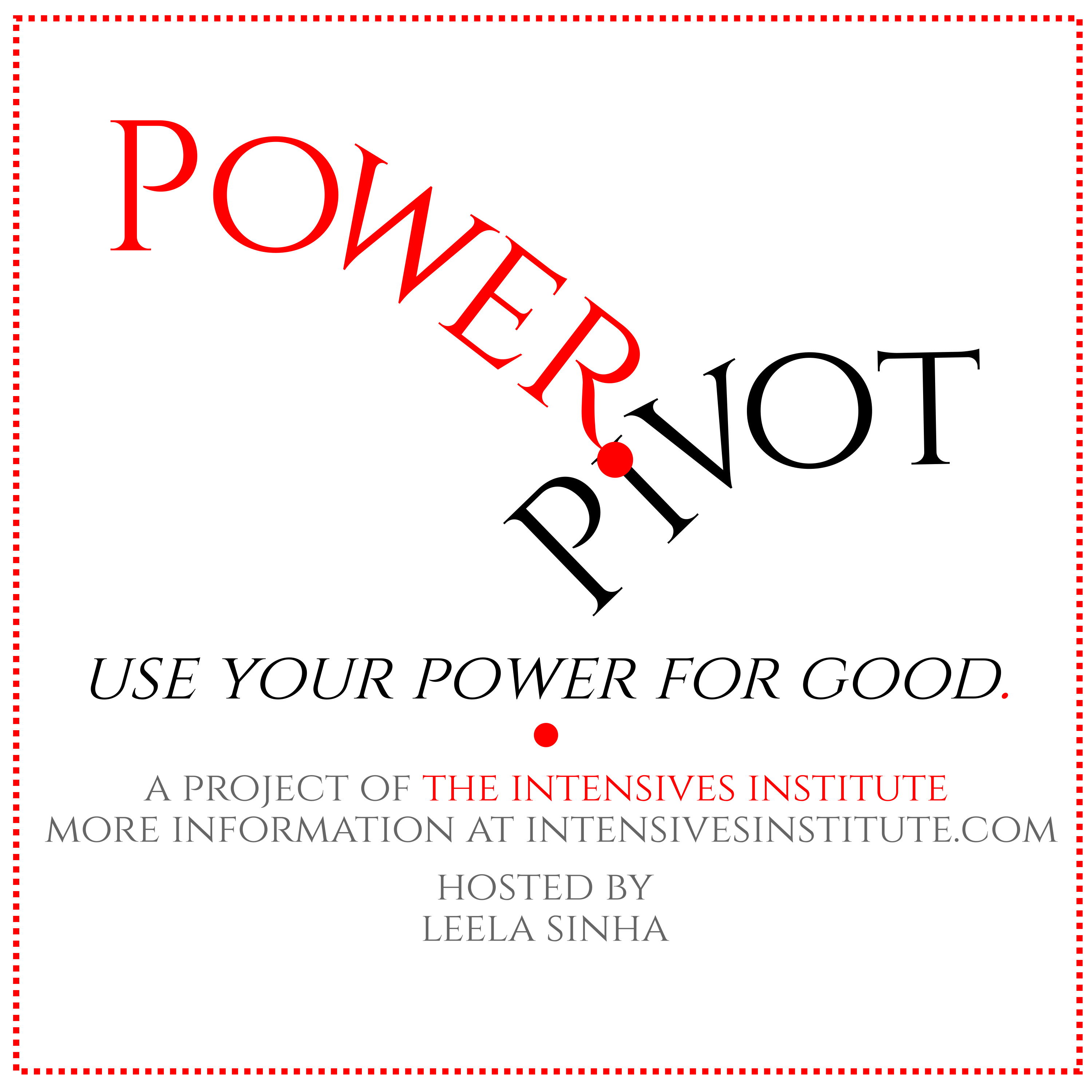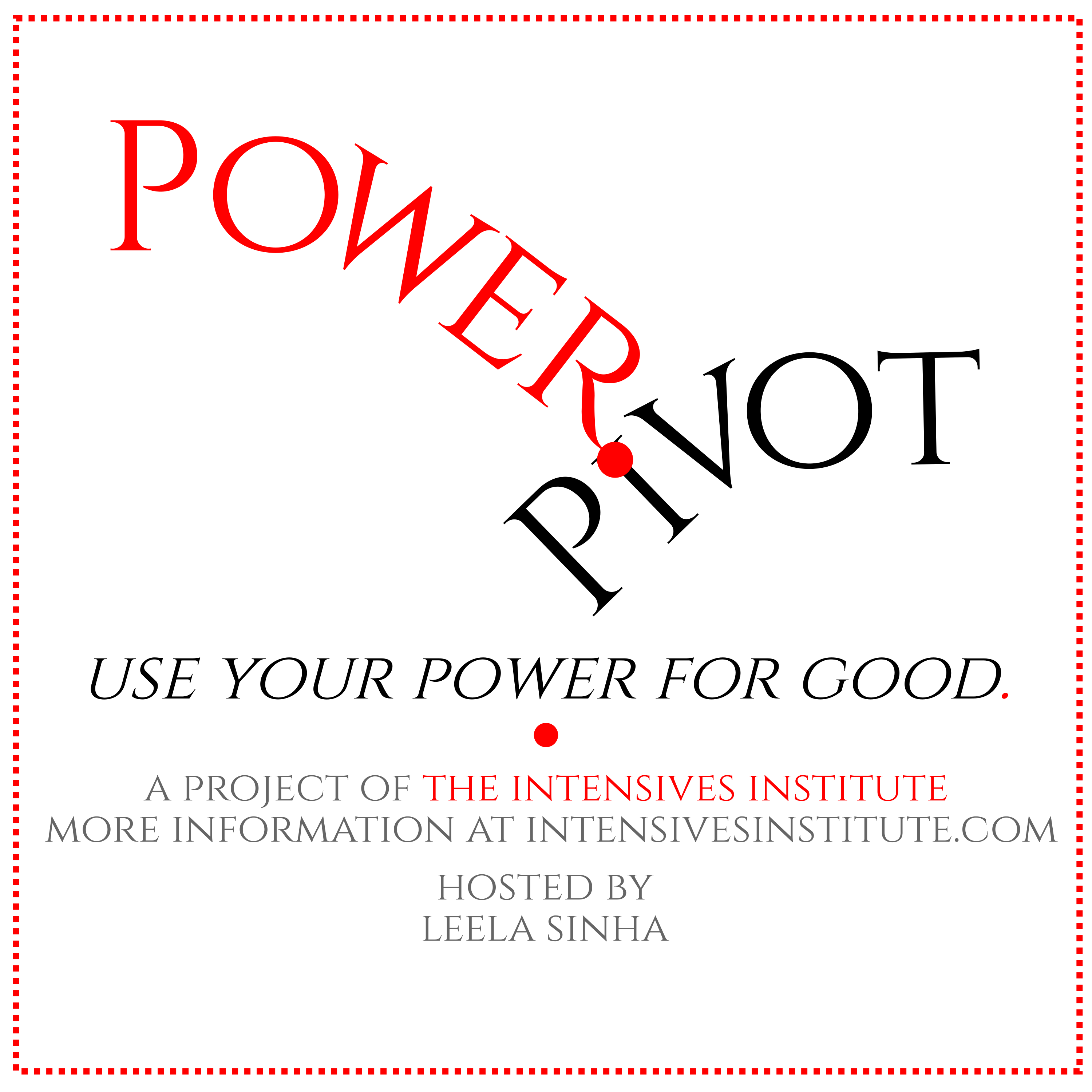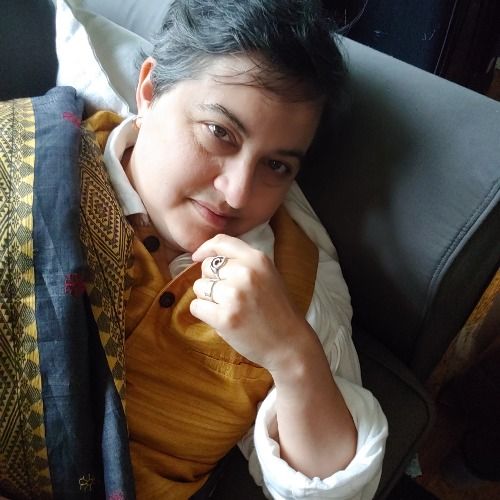Episode 4
the candy striped trousers
"I drew chalk outlines like some kind of strange murder scene. But nothing was being killed except my idea of myself as needing to be perfect."
On making one's own trousers, and on showing our true(er?) selves to the world.
Transcript and notes:
https://dev.intensivesinstitute.com/captivate-podcast/the-candy-striped-trousers
Recorded 12 June 2023.
Transcript
Hi, everyone, welcome to Power Pivot. Thanks for tuning in.
You can die of exposure. That's the first thing that comes to mind now, when I think of the word "exposure," which is part of the theme for July. Exposure, heat. Let the heat press down. Visibility. Sunny days. Deserts. That feeling of being a mouse in an open field with eagles circling overhead, and also that feeling of being at the top of the mountain.
Exposure. It's kind of got it all.
And what do we do with that as intensives? Some of us love it. Some of us love that raw wind on our skin, the bright sun on our heads. Some of us hate it with a passion. With a fiery distaste verging on rage. I don't want you to see me--do not perceive me: most of us are somewhere in the middle. We want to be perceived when we want to be perceived the way we want to be perceived.
But that's so hard to control that most of us prefer not, most of the time; except when we have something that we know is brilliant and big and going to change the world. And then we want everyone to listen. And then we would like to go back to our caves, please, thank you very much. Unfortunately, that's not how public attention works.
So if exposure means public attention, we need to figure this out. So you can die of exposure. You won't die of embarrassment. But sometimes it feels like you might.
Most of us as we approach and cross 40 and head fast toward 50 and 60 and 70, we become decreasingly interested in what other people think. There was a beautiful TikTok recently that was a series of interviews of people on the street, older women. All of them wearing fabulous, chaotic clothing. All of them absolutely committed to expressing themselves in their own clothes. It was in the spirit of such things, that one day, a few weeks ago, I woke up and decided that the candy striped white and red fabric that I had picked up for a song to make rough drafts of clothes out of was going to become a pair of casual pants.
At least some of it was. I need some lightweight trousers for the summer, you see, and I'm fed up with everything, fitting, that has to do with public clothing buying. There's nothing right about our garment system in this country. I have partially been spoiled by spending some time in India where custom made clothes are still fairly normal and clothing that adjusts easily is fairly normal. And even despite Westernization, there's a certain amount of appreciation for round bodies if you look.
And there are aunties everywhere, those of us of a certain age- I am now an auntie. I realized this when I was walking on the beach a few years ago in my sneakers and my kurta pajama and my jacket. And I looked exactly like the aunties that I had not quite understood fashion wise 10 or 15 years earlier. But now I get it. This is the clothing. This is what we've got. This is how we wear it. Would it make sense for us to start wearing- designing- demanding duster-length lightweight and mid weight coats to wear over our kurtas so that we don't look quite so ridiculous? Sure, but also sometimes the best thing is a parka. Anyway, I digress.
I decided to make these pants and I decided to make them as a sort of slapdash, all-in-a-day kind of project. I wanted the dopamine hit more than anything. I wanted to feel like I could complete things. I wanted to feel like I could keep some commitment, any commitment, to myself. Because it had been a while since anything had gone even remotely close to plan. So I took a pair of pajama pants that fit and laid them out on the fabric. I cut them. Just straight from the pajama pants. I drew chalk outlines like some kind of strange murder scene. but nothing was being killed except my idea of myself as needing to be perfect.
So I traced out the front and the back as best I could, rolling the pants around and stretching them and tugging them here and there. I cut them out. I put them together once. I discovered immediately that they were too small. That somehow I had managed to mis-measure one of the two pieces that I was literally physically tracing around. I had misunderstood or misjudged, or it had slid around, who knows? At any rate, it was too small.
So my first move was just a patch in a strip of fabric along the outer seams, one that looked exactly like the rest of the fabric and just blended in. It's a busy enough visual pattern that that extra strip of fabric wasn't particularly noticeable. And I was still reasonably satisfied with the outcome. And I put them together. And they worked okay. Somehow I had made the rise too big. Again, I don't know. I was guessing. I was improvising. I was deliberately slapdash. And one of the consequences of that is that sometimes you don't know where the problem is. But that was fine. It was really fine.
I rolled the hem over twice, I put a drawstring in. And then my waist just looked like every Catholic school girl when I was growing up with the hem rolled over so that her skirt would be shorter. Except I wasn't trying to make my skirt shorter, I was trying to keep my pants from dragging on the ground. I hemmed them as best I could, at a reasonable length. Again, mostly guessing. And they were done enough. And in an unusual stroke of what I can only call joy, I posted a triumphant picture of myself and said, Here's what I did with my day. I put it on social media. Here's what I did with my day.
ve been doing since about mid:So I posted this picture of myself in these pants. And then I considered whether I was actually willing to leave the house in these pants. Because while my two-thousand-odd people on Facebook can see me in them just fine, I'm not sure if the grocery store checker should get to see this. Facing someone in person is very different from facing someone on the internet. The first time I really went public in person with something that was dear and heart deep to me, I think was when I started preaching.
And the thing about preaching is that it is more exposing than giving a speech. Because there has to be something of you inside it or it's not alive. There has to be something compelling in it. There has to be something important in it. After all, whoever is before you got up, got dressed, got their kids dressed and drag them all to church. Or to the synagogue, or to your gathering space. Everybody came and got ready to listen to you. I mean they're there to pray or worship or celebrate or think together.
And also, they went through a fairly significant process to be there before you. There's a certain amount of respect that you owe them. At least that's how I see it. So it has to be, somewhat- Actually that's not true. It doesn't have to be anything. And there are always, as my colleague Heather Janules said a long time ago, good enough days.
There are good enough days when all you do is get up and do the best that you can. And sometimes it's not perfect and most of the time it touches people in a way that you couldn't have imagined anyway. So why are you even trying to have that audacity? Don't bother thinking about whether or not it's good enough because something- somewhere in there- is something that someone needed. Even if it was imperfect, maybe especially if it was imperfect.
My sewing is never perfect. I am not that kind of person. But also, I do not have that kind of skill. I'm mostly self taught. I spend a lot of time watching videos on YouTube about how to pad stitch or make perfect buttonhole, but then I gotta make the buttonhole and sometimes it works. And sometimes it doesn't. And buttonholes you really only get one chance, it's possible to clip out the threads and try again. But the fabric around the buttonhole is irreparably changed by the making of the buttonhole. So if it didn't work the first time, it's probably just going to get messier. And if it's serviceable, at least, it's probably better to leave it in place.
So my sewing does not look like the people that I watch. My buttonholes are not as neat and tidy as Sosteen's or Bernadette Banner's. I don't even have the relatively rough and tumble but still refined style of Zack Pinsent. I just have a needle and thread and I have to think of myself as a mediocre human being in a time, maybe at the beginning of sewing machines. Just putting things together. And even when I do modern construction, it's still imperfect.
And yet I put it out there. And people are kind of just delighted that I'm being in it. People like that I'm joyful. People like that I'm just doing a thing for the pleasure of doing the thing. And I think that's why those posts get so much attention. Which means that far more people saw me in my candy striped pants that were really only half done, then saw me in countless, medium- and-short form posts where I poured my heart out. Maybe it's the picture, and the algorithm.
Maybe it's that it's easy to comment on how cool my pants or my waistcoat are. It's a lot harder to come up with something significant to say when the post is complex and deep and nuanced and you might get in trouble for having your opinion or not. I don't allow people to be mean to each other in my comments. That's, that's not a thing we do in my living room. But still, sometimes people will disagree significantly. And as long as they're doing it in a respectful, healthy way, that is part of what we do in the living room. And that's how I think of myself being visible.
That's how I understand my visibility in the world is this, is this kind of space-holding, shit-stirring, engaging- working on engaging, engagement. Working on figuring out how to be in community together in conversation together, figuring out how to stumble along and recover, and lift each other up. Figuring out how we can be so deeply human. As e.e. cumming said "human merely beings." And also be ourselves.
That's what I think of myself. When I think of my visibility, that's what I think of. But you know what gets the most attention? Experimentation. Joy. Questions. Not even hope gets as many people. So what do we do with that? What do we do with that and that raw, exposed feeling of just putting our joy out there, especially on this internet, when so many people are so angry about so many people's joy? What do we do with that about that in that moment? And that tiny little window where we might hit post, in that tiny little window where we might tell people who we are and how we are for real. In that tiny little window where we might open the meeting with "it's been a hard day, so forgive me."
The opportunities we have to offer ourselves and each other grace. The opportunities we have to open doors, the opportunities we have to be the first one to stand up and do the weird thing in public. And the rush of joy and solidarity and cheering that comes when we do that. Sometimes because other people have been wanting to put themselves out there like that and it just took one person or two people or ten people before they felt like they could. And sometimes you're the first and sometimes you're the tenth. But it makes a difference to be that person. To stand out. It makes a difference.
And if we are intensives and we look around and we see other intensives and we interact with other intensives and we hear other intensives and we talk with other intensives you know what happens? We start to feel like we're really okay. Like we really do belong somewhere. Like it's possible for us to go through life without fighting every step of the way.
So when we reach for exposure for ourselves, when we put ourselves up in the spotlight, in the limelight, it means that we are opening our own doors and doors for others. And yes, it can be sunny and yes, it can be hot and yes, we can get sunburned. It can be brutal. We can get windburn. We can get frozen out. And also sometimes that's what allows us- being that exposed is what allows us to find our people.
That is why the Institute exists. To find our people. To uplift our people. To elevate intensives. To bring intensives together. To appreciate intensives and to make it possible for more people to find their people.
Thanks for tuning in. Talk with you soon.


